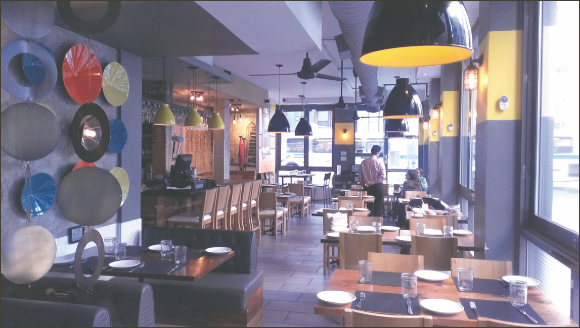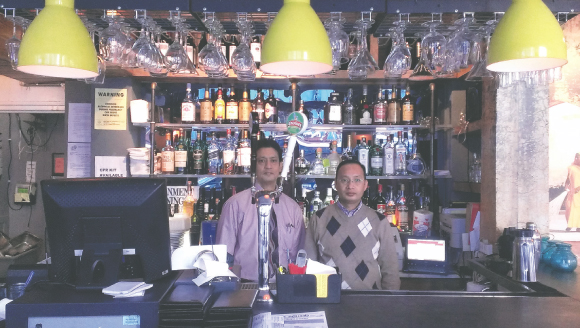Chote Nawab: Nawabon ka Khana for Everyday Prices
By Parth Dwivedi
NEW YORK, NY: Walking up to the corner of 28th St. and Lexington Ave. in New York City, a grey banner in stylized white lettering lets you know you have arrived at Chote Nawab, the latest talk of the area.
Shiva Natarajan, owner of Chote Nawab and other popular Indian restaurants in the area, explains that the name, or “little prince,” is intended to represent the Hyderbadi style of cuisine that they offer.
Walking in, one is met with a strong smell of masala and a hand painting of the eponymous movie poster. Grey and yellow earth tones bounce off of one another to create a well lit but relaxing lunchtime ambience, perfect for dinner as well. Depictions of quiet life in India accentuate the modern décor, adding to the laid back atmosphere.
Sitting down in one of the wooden chairs, you notice a selection of down-tempo Bollywood songs playing lightly in the background as your waiter brings out a glass jar, not a cup, full of water. It is all very quaint.
The Hyderbadi presence on the menu does not stop one from noticing a variety of dishes uncommon to Hyderbadi cuisine, like an entire seafood section.
Your plates arrive promptly, enveloped in a very strong aroma, enhancing the flavor; after all, smelling is half of tasting. Presentation is done well, with decorative tulsi leaves and thinly cut strips of ginger placed atop each of the dishes.
Their saag paneer is easy on the taste buds, with just enough spice to emphasize the saag in the dish without overpowering it. The chicken makhani is well-buttered and is so tender that it requires no knife to cut. It smells strong, but the taste is subtle, a great combination for any non-vegetarian food-lover. The chicken kabob is rich with texture, having a crispy exterior, with the same juicy succulence on its interior as the chicken makhani, and is complemented wonderfully by a squirt of lemon. Finishing strong with mango lassi, a strong burst of sweetness greets your palate—smooth enough to sip through a straw.
The devil is in the detail, and dining at Chote Nawab is a case study in subtlety.
Appropriately, restaurant-goers present cite the rich assortment of flavors as their own reason for coming and bringing newcomers along as well, explaining Chote Nawab’s rapid growth via word of mouth, as nearly fifty percent growth is projected within the next year. This growth has occurred amidst a relative vacuum of publicity aside from standard local directory services like Yelp, as Chote Nawab has never been reviewed by any major publication.
Natarajan explains his philosophy on establishing the restaurant, saying that he merely has a passion for food and wants to create an affordable and enjoyable experience for Chote Nawab’s patrons. Found in an area alongside many other Indian restaurants, some of which are also owned by Natarajan, Chote Nawab is intended mostly to satisfy a demand for specialized Indian food that one walking through the area would have anyway. Rather than competing with neighboring restaurants, he sees his restaurants as merely contributing to the neighborhood’s ethnic appeal. He says, “I don’t want to reinvent anything. India already provides such a large variety of cuisine that that in and of itself is enough to satiate any of our customers.”
All in all, the strong aroma walking into Chote Nawab grabs you, but the charming quaintness of the food and feel is what holds you.



